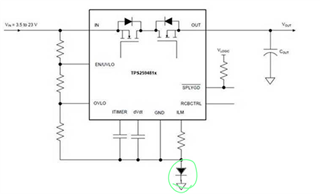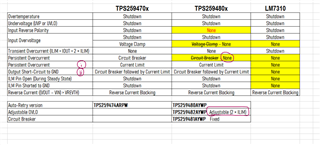Other Parts Discussed in Thread: TPS25947, LM7310
Tool/software:
Hi Kunal,
I want your expertise to select the best protection part for our device design.
I've attached a simple diagram to describe the configuration.
The device has two USB PD Source inputs, USB-C & Contacts, finally connected to the same Charger PMIC USB-C inputs, but not simultaneously!
1st is a regular USB-C PD receptacle connected directly to the charger PMIC and protected up to 28V_max with all set of OV/UV/InputCL and support of 5V OTG source.
OR
2nd is a "robust Contact" for the USB-C PD charger source connection in the docking or vehicular, routed to the same charger PMIC USB-C input with all above protections.
Therefore, I am looking for a Fuse or Ideal Diode on the 2nd "robust Contact" routed/shorted to the USB-C receptacle, VBUS input voltage.
This protection should be implemented on the flex, therefore the package should be small and have a simple footprint.
What is a more suitable part - TPS259480AYWP or TPS259470ARPW or LM73100?
eFuse / Ideal Diode requirements:
1.“Always Enabled” Power path for the 2nd USB PD charger hot plugging connection to the PMIC and PON event
2. Reverse voltage protection - to prevent VBUS Voltage on the contacts when the 1st USB-C PD Source is attached
3. Vin_max_abs <28V USB-C PD
4. VBUS I_load =3-4A maximum
5. INTERNAL B-2-B FETs Rds_on < 20mOhm
6. OVP-adj
7 . UVP-adj
8 . Reverse Current protection (when short circuit on external contacts VBUS+&-)
9. Slew rate control while the 2nd Charger source connection (Auto-Retry)
Thanks
Vitaliy



